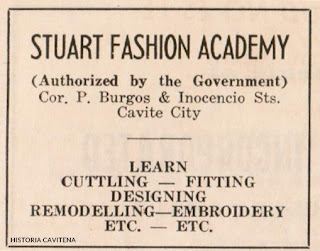1901 Entrance to Cavite City and 5 years before the 13 Martyrs Monument was built.
Credit : Historia Caviteña
September 12, 1896 at Plaza de Armas, Fort San Felipe (constructed in the year 1637), the people of Cavite personally witnessed the execution of the thirteen (13) honorable and patriotic sons of the land. They were implicated in the propaganda and accused in instigating revolutionary movement against Spain, while some for being suspected members of the Katipunan, and others for being an active Masons. On August 31, 1896, one by one, they were arrested, and executed on September 12, 1896. Among the thirteen martyrs shot, ten were Masons, namely: Maximo Inocencio, 64, a rich proprietor; Jose Lallana, 54, a tailor and a former corporal of the Spanish Marines; Eugenio Cabezas, 41, a clerk at the Cavite Arsenal; Maximo Gregorio, 40, another clerk at the Cavite Arsenal; Hugo Perez, 40, a physician and a member of the Katipunan; Alfonso de Ocampo, 36, a Spanish mestizo who is also a member of the Katipunan; Severino Lapidario, 38, Chief Warden of the Provincial Jail and another member of the Katipunan; Luis Aguado, 33, an employee of the Cavite Arsenal; Victoriano Luciano, 32, a pharmacist and poet; and Feliciano Cabuco, 31, an employee of the Navy Hospital in Cavite. The Three Non-Masons were: Francisco Osorio, 36, a Chinese mestizo and contractor; Antonio de San Agustin, 36, a surgeon and businessman; and Agapito Conchu, 33, a teacher, musician and painter. The lifeless bodies of the Sons of Cavite were carried into a garbage cart, guarded by six Spanish soldiers armed with rifles and bayonets brought to the Convent cemetery at Caridad. The wealthy family of Maximo Inocencio, Francisco Osorio, Luis Aguado, Hugo Perez and Victoriano Luciano buried their remains appropriately in separate coffins but the underprivileged one, Maximo Gregorio, Feliciano Cabuco, Antonio San Agustin, Agapito Conchu, Eugenio Cabezas (brother of Roberto Cabezas, the first candidate of Bagong Buhay Lodge No. 291), Jose Lallana, Severino Lapidario and Alfonso de Ocampo without caskets were buried altogether in only one grave. After eight years, in June 1904, a group of young men and other inhabitants of the community known as the “Samahan ng Kabataang Kabitenyo”, (Association of Young Cavitenos) held a dance party, thereat, the group decided to sponsor a meaningful project, in honor of the 13 Martyrs of Cavite. On Monday night, September 12, 1904 at Ballesteros Street, now named in honor of Hugo Perez, one of the 13 Martyrs, the nationalistic young Cavitenos held a formal meeting and a committee was formed chaired by Don Ceferino Picache, Past Master of Bagong Buhay Lodge No. 17 (1936) and discussed the possibility of putting up a monument in honor and memory of the 13 Martyrs of Cavite. The following Saturday night, September 17, 1904, Dona Baltazara Adriosola Reyes suggested to invite and involved wealthy family in the community. On Sunday afternoon of September 25, 1904, together with the invited guests, they agreed to raise funds through donations of the members, distinguished and other wealthy Cavitenos in the community. They also formed a Comite Ejecutivo (Executive Committee) chaired by Dr. Catalino Nicolas, Don Juan Matias, Secretary and Don Nicasio Desiderio, Treasurer, to oversee the project. After one year, they were able to raise 1,000 pesos and they started to put up the foundation. In the afternoon of September 12, 1905, a simple program was held with Joaquin Balmori and Jose Turiano Santiago of Manila and Alejandro Fojas of Tanza, Cavite were invited as guest speakers. Ten years after the execution of the 13 Martyrs, September 12, 1906, the Cavitenos led by brother Masons of Bagong Buhay Lodge marched from Magallanes Street, Cavite District Proper up to the Convent cemetery in Caridad. The remains of the Martyrs were exhumed and in public procession, again led by brother Masons escorted, transferred and interred in the newly constructed final resting place at Isthmus of Rosario, now called “The Thirteen Martyrs Centennial Plaza. The Monument was formally inaugurated, in honor and memory of the departed Sons of Cavite. At the inner part or basement of the monument, a box made of mulawen wood covered with thick lead are documents of agreement in the construction of the monument written in a papel culado or pergamino (bleached or white paper) while newspapers/bulletins were saved in a bungbong na bubog (glass cylinder), where all expressions of appreciations and recognitions in the construction of the monument were written. Also preserved are old currencies in different denominations used at that time. The President of the Executive Committee, Dr. Catalino Nicolas and Don Gervacio Pangilinan, Cavite Historian, Municipal President of United Cavite (1919-1921), and Past Master of Bagong Buhay Lodge No. 17 (1937) during the affair, delivered a short but meaningful and memorable messages while Dr. Justo Lukban expressed his own in a form of poem, and since then the commemoration was celebrated annually. In 1930, Bro. Ramon Samonte, of Bagong Buhay Lodge No. 17, Municipal President of United Cavite (1928-1930, 1931-1933) and in 1997, Atty. Timoteo O. Encarnacion, Jr., Cavite Historian and Mayor of Cavite City (1989-1992, 1992-1995, 1995-1998, 1998-2001) led the renovation of the monument in a more distinctive and significant views.













